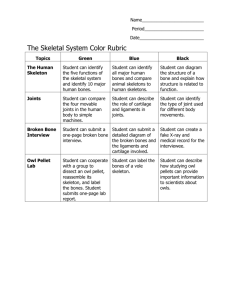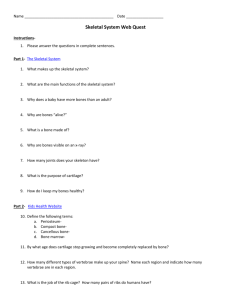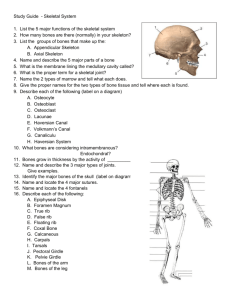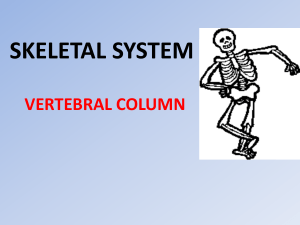Systems of the Body
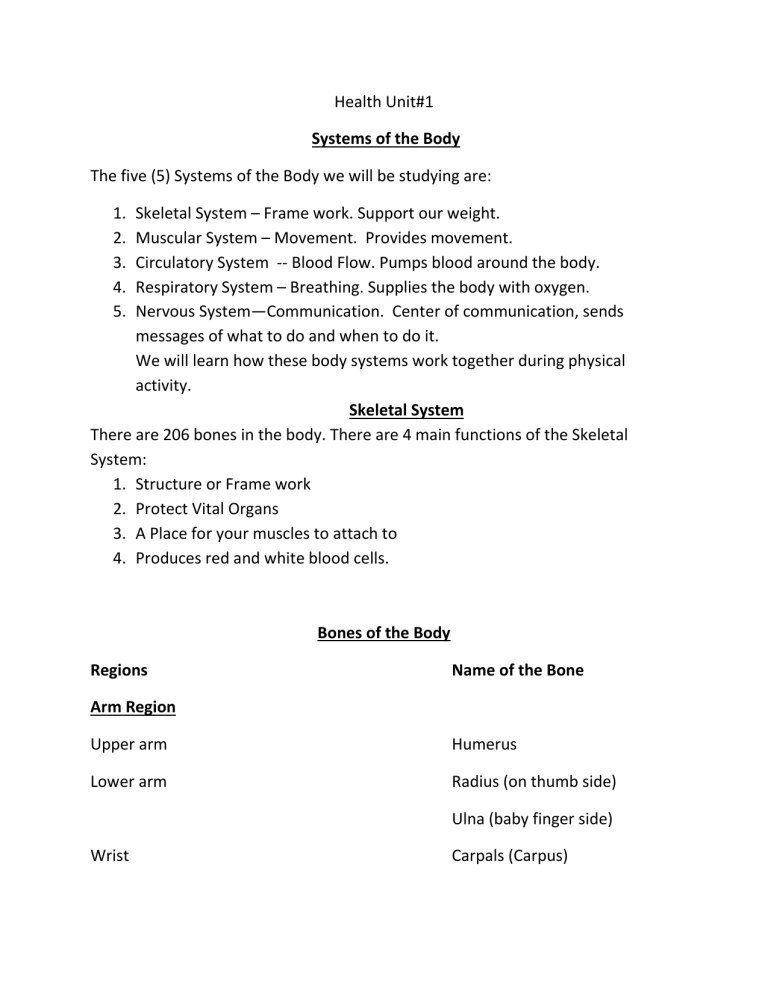
Health Unit#1
Systems of the Body
The five (5) Systems of the Body we will be studying are:
1.
Skeletal System – Frame work. Support our weight.
2.
Muscular System – Movement. Provides movement.
3.
Circulatory System -- Blood Flow. Pumps blood around the body.
4.
Respiratory System – Breathing. Supplies the body with oxygen.
5.
Nervous System—Communication. Center of communication, sends messages of what to do and when to do it.
We will learn how these body systems work together during physical activity.
Skeletal System
There are 206 bones in the body. There are 4 main functions of the Skeletal
System:
1.
Structure or Frame work
2.
Protect Vital Organs
3.
A Place for your muscles to attach to
4.
Produces red and white blood cells.
Bones of the Body
Name of the Bone Regions
Arm Region
Upper arm Humerus
Lower arm
Wrist
Radius (on thumb side)
Ulna (baby finger side)
Carpals (Carpus)
Palm
Fingers
Leg Region
Upper Leg
Knee
Lower Leg
Ankle
Instep
Heel
Toes
Truck Region
Shoulder
Chest
Metacarpals
Phalanges
Femur (Largest)
Patella (Knee Cap)
Tibia (Shin)
Fibula
Tarsals
Metatarsals
Calcaneus
Phalanges
Clavicle (Collar Bone)
Scapula (Shoulder Blade)
Sternum
Bones Continued
Ribs
Ribs—There are 5 pairs directly attached to the sternum.
There are 5 pairs indirectly attached to the sternum.
There are 2 pairs of floating ribs.
Vertebral Column ( Neck, chest, lower back tailbone)
There are 7 cervical vertebrae
There are 12 thoracic vertebrae
There are 5 lumbar vertebrae
4 Vertebrae fused (attached to sacrum called the coccyx)
5 Vertebrae fused together (sacrum)
3 Rib Locations—Vertebral Column, Chest and Lowerback
Tailbone
There are 5 bones fused together to form the sacrum and 4 fused together to form the coccyx . These make up the tailbone region.
Hipbone (Pelvis)
There are 5 moveable joint that make up the Hipbone (Pelvis)
1.
Hinge Joint—the hinge joint allows movement in one plane only. Examples:
Knees, and elbows
2.
Ball and Socket Joint—the rounded head of one bone fits into the cavity made by the other bone or bones. Examples: Shoulders and hips
3.
Gliding Joint – a joint that allows for a sliding movement across one bone to another bone with very little movement at each bone. Examples: Carpals,
Metacarpals, Phalanges, Tarsals, Metatarsals.
4.
Saddle Joint –a joint with a convex surface resting on a concave surface.
Example: Base of the Thumb
5.
Pivot Joint – is a joint that allows rotary movement. Example: neck
Joints – are where the bones are connected. They are held together by various connective tissues including ligaments and muscles.
6 Major Joints
1.
Wrist
2.
Elbow
3.
Shoulder
4. Hip
5. Knee
6. Ankle
Your skeleton is flexible because of the movement capable at the joints of the body. The range of movement depends on the structure of the joint, the muscle attachment and connective tissue present.
Three (3) Types of Connective Tissue
1.
Cartilage – is the cushion between the joints, maintains shape, Examples: ears and nose and absorbs shock.
2.
Tendons—they connect muscles to bones. Example: Achilles tendon
3.
Ligaments—they connect bone to bone, not very elastic, white fibrous tissue.
Joint Movements
Anatomical position— is standing upright with your arms by your side and palms facing forward.
Two (2) Planes in the Body
1.
Frontal Plane—divides the body into a front half (anterior) and back half
(posterior).
2.
Medial Plane—divides the body into a right half and a left half.
Eleven (11) Joint Movements
1.
Flexion—is where the angle at the joint decreases. Decreases the angle between the two bones. Example: Elbow (Bending your arm)
2.
Extension—is where the angle at the joint increases and returns to the normal anatomical position. Increases the angle of the two bones. Example:
Elbow (Straightening your arm)
3.
Hypertension—is the continuation of extension beyond the normal anatomical position. Example: Wrist and neck (Bending your wrist backwards)
4.
Abduction—is the movement away from the medial plane. Example: Arm
(Moving your arms away from your side)
5.
Adduction—is the movement towards the medical plane. Example: Arm
(Moving your arms towards your side)
6.
Rotation—is the movement around a central axis. Example (Head)
7.
Circumduction—describes the shape of a cone.
8.
Supination—is lying down, face up.
9.
Pronation – is lying down face down.
10.
Eversion—is where the soles of your feet are turned outward.
11.
Inversion—is where the soles of your feet are turned inward.
Skeletal System Test
Physical Education 10
Mr. Huggard
A.
Name the five (5) types of joints.
1.
2.
3.
4.
5.
B. Name the three (3) types of connective tissue and explain their function.
1.
2.
3.
C Name the four (4) functions of the Skeletal System.
1.
2.
3.
4.
D. What is the anatomical position?
E. Label the 20 bones of the body on the diagram.


